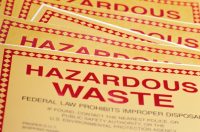Tag: EPA
PCB Marking Requirements
Each of the following items must be marked with the large label as illustrated in this section. Where the large PCB mark is specified, but the PCB article or PCB equipment is too small to accommodate the smallest permissible size of the large mark, the small PCB mark may be used instead of the large […]
Lamp Recycler Fined for PCB Violations
According to EPA, the facility is permitted under the Toxic Substances Control Act (TSCA) to manage and store PCB wastes. Separate permits allow the facility to recycle fluorescent lamps and ballasts, batteries, electronic wastes, and mercury devices. The facility also manages non-PCB ballasts, phosphorous powders, aerosol cans, and mercury-containing wastes. The company operates facilities in […]
14 Expert Tips for Responding to NOVs and Enforcement Orders
Have a procedure in place for responding to NOVs, enforcement orders, and other related issuances. Give a copy of an NOV or order to the person responsible for responding. If the alleged violation is significant, make sure to alert the proper management official. Immediately determine the validity of the NOV or order. Mark all documents […]
More on Used Oil Generator Requirements
Used Oil Handler Activities A generator’s used oil activities may subject the generator to the responsibilities of one or more other used oil handler categories. These requirements would be in addition to those required of generators. Other handler categories and the activities that would subject the generator to these additional requirements are: Transporters. Generators who […]
The golden rules for construction stormwater management
Sediment is usually the main pollutant of concern; according to the EPA, sediment runoff rates from construction sites are typically 10 to 20 times greater than the rates from agricultural lands, and 1,000 to 2,000 times greater than those of forest lands. In fact, during a short period of time, construction sites can contribute more […]
Are You a Used Oil Generator?
Storage Requirements The rules state that generators must not store used oil in units other than tanks, containers, or units regulated under 40 CFR 264 or 40 CFR 265 (40 CFR 279.22(a)). (Tanks include both aboveground storage tanks (ASTs) and underground storage tanks (USTs)). According to EPA, this does not mean that the ASTs or […]
SO2 NAAQS: What’s Next?
By Timothy P. Fagan, BLR Air Expert tfagan@blr.com How were nonattainment designations determined? Once the NAAQS was set in 2010, EPA and state agencies worked together using monitoring data to determine what areas should be designated nonattainment and establish the area’s boundaries. The newly designated nonattainment areas were designated as such because each had air […]
E-Learning Makes Training Easy
In some cases, EPA specifies general types of training (e.g., classroom or hands-on) and time frames for refresher training but leaves the duration of training and choice of training materials up to facility managers. For example, EPA requires hazardous waste large quantity generators and treatment, storage, and disposal facilities to provide classroom instruction or on-the-job […]
EPA/Corps’ U.S. Waters Guidance Still on Hold
As used in rulemaking, the phrase “waters of the United States” most often refers to waters subject to CWA Section 404 dredge and fill permitting as implemented by the Corps and subject to EPA approval. But in the draft guidance, the agencies make it clear that the phrase extends to other major programs administered under […]


